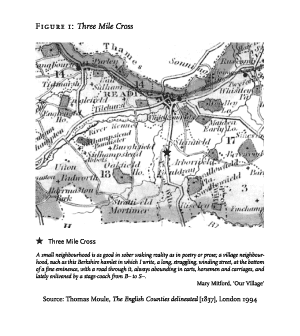There is a very simple question, about literary maps: what exactly do they do? What do they do that cannot be done with words, that is; because, if it can be done with words, then maps are superfluous. Take Bakhtin’s essay on the chronotope: it is the greatest study ever written on space and narrative, and it doesn’t have a single map. Carlo Dionisotti’s Geografia e storia della letteratura italiana, the same. Raymond Williams’s The Country and the City, the same. Henri Lafon’s Espaces romanesques du XVIIIe siècle . . . Do maps add anything, to our knowledge of literature?
Village stories were a popular British genre of the first quarter of the nineteenth century, peaking with Mary Mitford’s Our Village, published in five volumes between 1824 and 1832. The village was Three Mile Cross, in Berkshire (figure 1, below), a dozen miles south of Reading, on the road to Hampshire; and the road is explicitly foregrounded in Mitford’s opening sketch, where it also forms the basis for her presentation of the village as one house after another along a ‘straggling, winding street’. So you think, ‘Yonville’,footnote1 and imagine this village of two or three hundred people as a mere site of transit between larger places (Effi Briest: ‘no, the Gdansk–Berlin express does not stop here . . .’). Easy.
Then you make a map of the book, and everything changes. The twenty-four stories of Mitford’s first volume, figure 2 shows, arrange themselves in a little solar system, with the village at the centre of the pattern, and two roughly concentric rings around it. The first ring is closer to the village, and focuses largely on personal relationships (‘Ellen’, ‘Hannah’, ‘Cousin Mary’); the second ring, more numerous, is at a distance of a couple of miles, and emphasizes natural spectacles (‘Frost and thaw’, ‘Violeting’, ‘The first primrose’), plus collective events like cricket and maying. But in both cases the road ‘from B– to S–’, so present at the beginning of the book, has disappeared: narrative space is not linear here, it is circular. Which is surprising: while mapping nineteenth-century genres for the Atlas of the European Novel I encountered all sorts of shapes—linear trajectories, binary fields, triangulations, multi-polar stories—but never a circular pattern. Where on earth do these rings come from?
John Barrell, The Idea of Landscape and the Sense of Place 1730–1840:
There is a sense in which an open-field parish in the late eighteenth and early nineteenth centuries [which is exactly what the one in Our Village is like] could be said to have a different geography according to who was looking at it: thus, for those of its inhabitants who rarely went beyond the parish boundary, the parish itself was so to speak at the centre of the landscape . . . For those inhabitants accustomed to moving outside it, however, and for those travellers who passed through it, the parish was . . . defined not by some circular system of geography but by a linear one.footnote2
A circular ‘system of geography’, and a linear one: behind these two perspectives, lies the dramatic transformation of rural space produced by parliamentary enclosure, which Barrell has so well visualized in his two maps of Helpston, and where a perceptual system centered in the isolated village is replaced by an abstract network of roads (figures 3–4). Against this background, Our Village’s spatial pattern becomes much clearer: by opening with a linear perspective, and then shifting to a circular one, Mitford reverses the direction of history, making her urban readers (Our Village was published by Whitaker, Ave-Maria-Lane, London) look at the world according to the older, ‘centered’ viewpoint of an unenclosed village. And the key to this perceptual shift lies in Mitford’s most typical episode: the country walk. Story after story, the young narrator leaves the village, each time in a different direction, reaches the destinations charted in figure 2, then turns around and goes home. ‘When a system is free to spread its energy in space’, writes Rudolf Arnheim, ‘it sends out its vectors evenly all around, like the rays emanating from a source of light. The resulting . . . pattern is the prototype of centric composition.’footnote3 Exactly: out of the free movements of Our Village’s narrator, spread evenly all around like the petals of a daisy, a circular pattern crystallizes—as it does, we shall see, in all village stories, of which it constitutes the fundamental chronotope. But in order to see this pattern, we must first extract it from the narrative flow, and one way to do so is with a map. Not, of course, that the map is already an explanation; but at least it shows us that there is something that needs to be explained. One step at a time.
A rounded pattern in Helpston before the enclosure; and a rounded pattern in Our Village. But with a difference: in Mitford’s walks, Barrell’s ‘rough circle . . . in which the villagers work and move’ is rewritten as a space of leisure rather than work. Slow easy strolls, thoughtless, happy, in the company of a greyhound called May; all around, a countryside full of picturesque natural views, but where very few people are actually doing anything. Decorative: for each page devoted to agricultural labour, there must be twenty on flowers and trees, described with meticulous precision. If urban readers are made to share the village’s perception of space, then, it’s also true that this space has been thoroughly gentrified; as if Mitford had travelled forward in time, and discovered what city-dwellers will want to find in the countryside during a brief week-end visit. Not surprisingly, country walks were by far the most popular part of Our Village, and remained long in print by themselves while the rest was forgotten.



